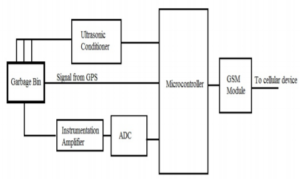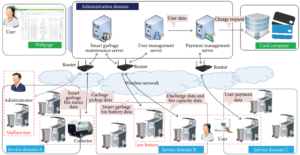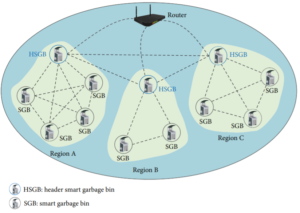An example of this service platform is a mobile app that the truck driver uses to determine whether the container should be emptied or not. This saves the travelling time, which reduces the transportation cost and carbon footprint produced by the vehicle. Citizens can also check the fullness of containers, so the area around them does not get messy from overflowing. These long-lasting sensors can be attached on most if not all kinds of containers in any place making them easy to install, thereby further reducing the installation and operating cost.
This system can potentially be improved by replacing or modifying existing containers to be sealed. Many waste containers may spread a bad odour, specifically for food waste in the summer. Since the sensors work via ultrasonic waves, a sealed container will not make any difference to the performance. It may require some time and extra capital to implement this, but in the long run it may be feasible. Additionally, it can help regulate the amount of garbage that people can dispose of. Traditionally, there are no restrictions on the amount of waste that normal households can produce in many cities. By integrating a weight sensor, the entrance of the container would not open if the weight exceeds the limit. It is unusual that a normal household or people to produce an absurd amount of waste, but it will give an incentive to lean towards waste-free. Thakker and Narayanamoorthi2 demonstrates a schematic example of and IoT based smart waste management system (Figure 1).

Figure 1 – Block diagram for a smart garbage bin.
The specific process of setting up the system may differ from a designer to another, but the idea of it is the same. Thakker and Narayanamoorthi decided to add extra cells to act as secondary sensors in case of the emergency where ultrasonic sensors fail to operate. As the bin fills up, the GSM module sends out a signal that indicates the bin is filling up. This then activates the GPS module to send out a signal that shows where the bin is located. The microcontroller is used to save energy by turning on and off the cells in intervals, as known as pulse-width modulation (PWM). For instance, this can be done in the way where the monitoring of the bin is turned off for 20 minutes every 2 hours (arbitrary timeframe). Another method would be adding motion sensors, so that the power turns on only when the garbage enters the bin.

Adding on to the details of smart garbage system, servers in the network are considered: a smart garbage server, a user management server, and a payment management server1. This would involve registering a RFID card that gets recorded each time the user uses the garbage bin. The user management server deals with waste discharge information and the personal information that is registered on the RFID card. The waste discharge information would focus on the amount of waste, the kind of waste, and the region where this was recorded. The payment management server would allow the users to pay through the registered RFID card; depending on the amount of waste, for example. The smart garbage server would check the status of each smart garbage bin, whether that is functionality, waste level, and/or the amount of waste the collection company has gathered. Moreover, adding a “master” smart garbage bin would allow it to analyse the information of the other smart garbage bins in the designated region.

Figure 2 shows a diagrammatic representation of this system that was employed in Seoul, South Korea.
There are other benefits to smart waste management system excluding the reduction of carbon footprint and transportation cost. Due to less travelling time, noise production from the trucks are reduced. Often, garbage trucks are loud to provide power to lift heavy containers. It also makes the city look classier, encouraging smart lifestyle.
Issues also may rise due to this system. Using the example with RFID cards, if they malfunction or break then it would make the process of waste management inefficient. Plus, these cards could be adversely affected by metal surroundings due to its nature. However, the emphasis of smart city projects is to improve the overall quality of life in a city. Therefore, there is high chance that the issues which arise with smart projects, especially small issues like the ones mentioned above, would be solved rather quickly. That being stated, technical problems would likely not exist from the get-go as the developers would make sure the final results are sound. This may seem like a bold assumption, but considering the pressure of entering a new market and the public’s high expectation, the risks are too high, which gives more reasons to perform well.